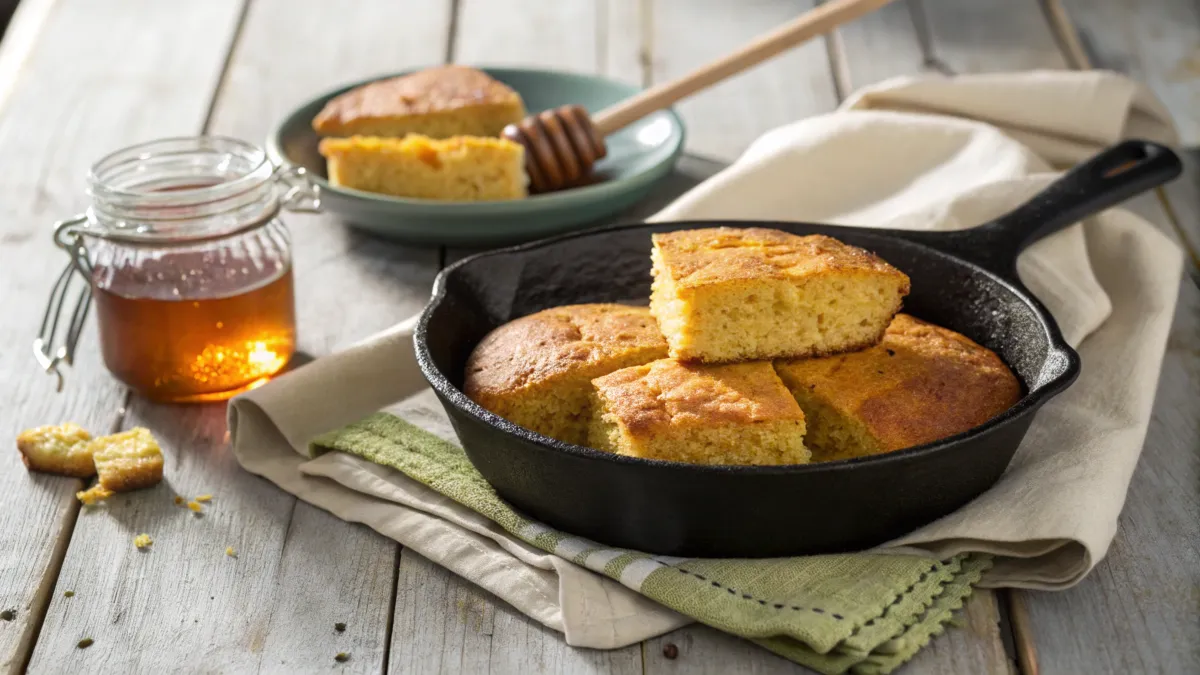Cornbread stands as one of the most iconic dishes in Southern cooking. It’s a food deeply rooted in history and tradition, reflecting the culture, creativity, and tastes of the South. However, a long-standing debate continues to divide even the closest families: Why Do Southerners Not Put Sugar in Cornbread? For many Southerners, the answer is a resounding no. This article dives into the historical, cultural, and practical reasons behind this culinary choice, offering a closer look at Southern food traditions.
First, we’ll explore the origins of cornbread and its significance in Southern culture. Next, we’ll examine how regional differences, and personal preferences have influenced recipes over time. Finally, we’ll discuss why this humble, yet divisive dish holds such a special place in Southern kitchens. By the end, you’ll gain a deeper appreciation for the story behind this beloved food.
Table of Contents
The History of Cornbread in the South
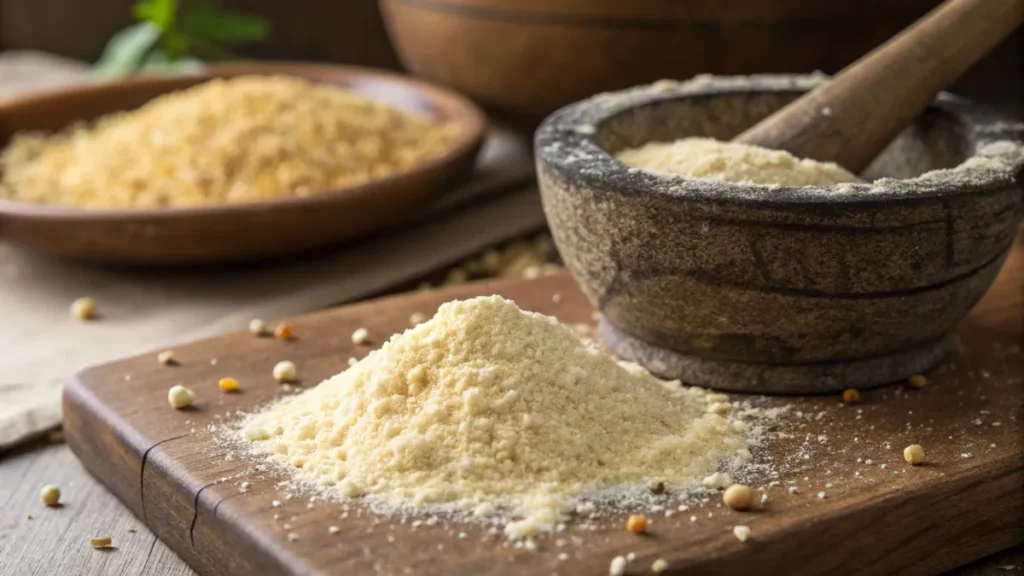
Cornbread’s Origin in Native American Cuisine
Cornbread has deep roots in Native American cuisine. Long before European settlers arrived, Native Americans used cornmeal to create simple, bread-like dishes. They ground dried corn into meal, mixed it with water, and cooked it over an open flame or on hot stones. This method laid the foundation for what we now know as cornbread.
Native Americans didn’t add sweeteners to their cornbread. Instead, they focused on practicality and sustenance. Corn was an abundant and versatile crop, making it a staple in their diet. Early settlers adopted this approach, and it eventually became a Southern tradition.
Evolution of Cornbread in Southern Cooking
When European settlers arrived in the Americas, they brought with them a love for bread but quickly discovered that wheat wasn’t ideal for Southern soils. Corn, on the other hand, thrived in the region. As a result, settlers began experimenting with cornmeal to create bread alternatives.
Over time, Southern cornbread evolved to include ingredients like buttermilk, eggs, and fat, but it remained simple and unsweetened. For most Southerners, cornbread was a savory side dish meant to complement hearty meals, not compete with dessert.
Why Sugar Wasn’t Traditionally Used in Cornbread
In the South, cornbread wasn’t seen as a treat it was everyday food. Adding sugar to it was considered unnecessary and even wasteful. Sugar was expensive and often reserved for special occasions or desserts. Families relied on cornbread as an affordable and filling staple, especially during tough times like the Great Depression.
Additionally, the traditional flavor profile of Southern cuisine leans toward savory rather than sweet. Cornbread was paired with beans, greens, or stews, where its savory notes balanced the richness of the meal.
This foundational history sets the stage for understanding why many Southerners still avoid sugar in their cornbread. In the next section, we’ll explore how regional differences contributed to the ongoing debate about this beloved dish.
Regional Differences in Cornbread Recipes
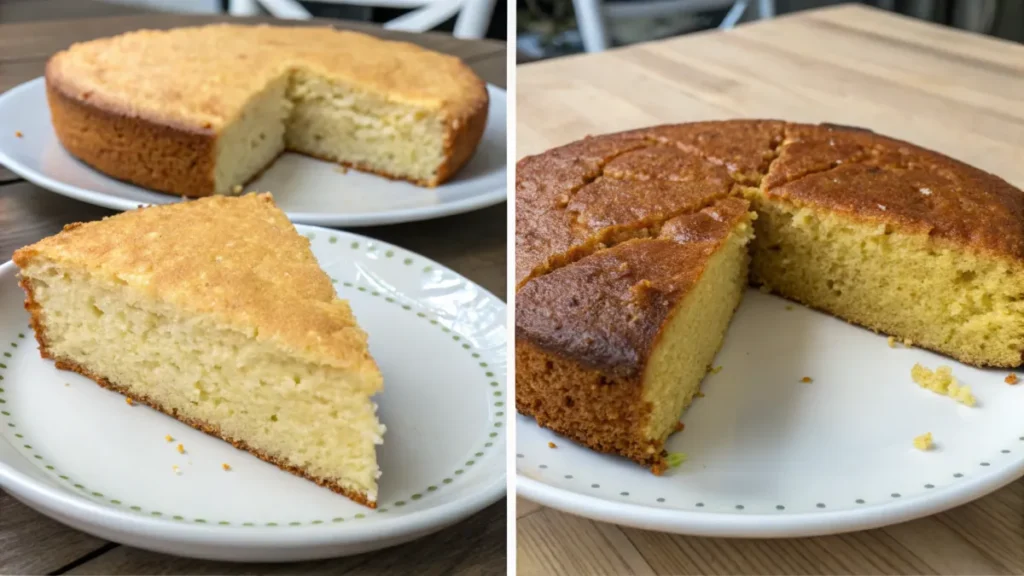
Northern vs. Southern Cornbread: Key Differences
One of the biggest differences between Northern and Southern cornbread is sweetness. Northern cornbread often includes sugar or other sweeteners, giving it a cake-like texture. Southerners, however, prefer their cornbread savory, highlighting the natural flavors of cornmeal. This divide is more than a preference it reflects cultural differences in cooking traditions.
Northern cornbread also tends to be fluffier, resembling a quick bread. Southern cornbread, on the other hand, is typically crumbly and dense. The use of white cornmeal in the South contrasts with the yellow cornmeal often used in the North. These variations stem from differences in available ingredients and regional palates.
For a great Southern cornbread recipe, check out this savory cornbread guide from Simply Recipes.
The Role of Ingredients in Defining Regional Styles
Ingredients play a crucial role in shaping cornbread’s flavor and texture. In the South, buttermilk and bacon drippings are often used, adding a tangy and savory depth. These ingredients reflect a reliance on what was locally available to Southern cooks. In contrast, Northern recipes frequently call for butter and milk, which were more accessible in colder climates.
The type of cornmeal is another factor. Southern cooks favor stone-ground cornmeal, which retains more of the natural oils and nutrients. This gives the bread a rich, authentic flavor that many Southerners hold dear.
How Cultural Preferences Shaped Cornbread Recipes
Cultural influences have shaped cornbread recipes over centuries. Northern cuisine leans towards sweeter dishes, influenced by European baking traditions. Southern cuisine, rooted in resourcefulness and simplicity, favors savory profiles. Cornbread was often paired with vegetables or beans, making sugar unnecessary and even unwelcome in the South.
Practical Reasons for Avoiding Sugar in Southern Cornbread
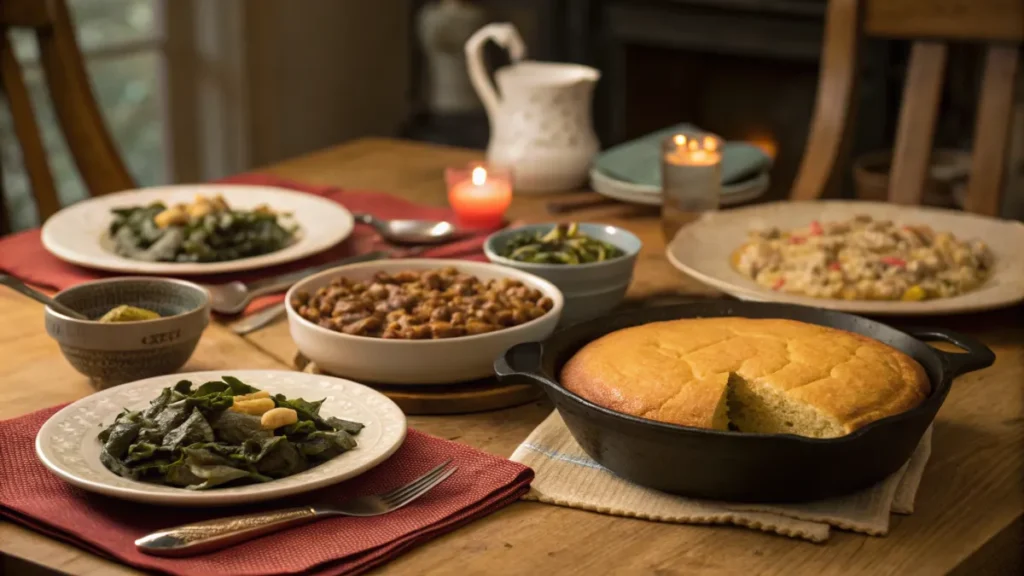
Accessibility of Ingredients in the 19th Century South
In the 19th century, sugar was a luxury item in the South. Many families lived in rural areas where access to store-bought goods was limited. Cornbread was a staple food, made with simple, readily available ingredients like cornmeal, water, and salt. Adding sugar was impractical and often seen as wasteful.
Even today, many Southerners adhere to these traditions, valuing the authenticity of unsweetened cornbread. This historical context explains why Southerners do not put sugar in cornbread.
Taste Preferences of Southerners Over Generations
Southern palates have always leaned towards savory flavors. Foods like greens, beans, and stews were typically seasoned with pork or fat, and cornbread served as a complementary side. The absence of sugar allowed the cornmeal’s natural flavor to shine and balanced the richness of the main dish.
Generational cooking habits play a role too. Families passed down recipes without sugar, preserving this tradition. To many, sweet cornbread feels out of place, almost like a dessert masquerading as a side dish.
The Influence of Traditional Cooking Methods
Traditional Southern cooking methods also shaped cornbread’s flavor profile. Cornbread was often baked in cast iron skillets, creating a crispy crust and savory taste. This rustic cooking method further emphasized simplicity. Adding sugar wasn’t just unnecessary it could disrupt the balance of flavors that made cornbread a beloved part of Southern meals.
Cornbread as a Cultural Symbol in the South
Cornbread’s Role in Southern Hospitality
Cornbread is more than a side dish in the South it’s a symbol of hospitality and comfort. Many Southern families take pride in serving freshly baked cornbread at gatherings, where it often accompanies classic dishes like collard greens and fried chicken. The act of making cornbread for guests demonstrates care and a connection to tradition.
Southern hospitality is about more than just food; it’s about creating a welcoming atmosphere. Cornbread’s simple, wholesome nature fits perfectly into this ethos. Its familiar taste and rustic texture evoke memories of family meals and cherished recipes passed down through generations.
For a modern twist on cornbread that preserves its traditional roots, you can explore this classic cracklin’ cornbread recipe on Charmed Recipes.
Traditions Passed Down Through Families
One reason why Southerners do not put sugar in cornbread is the strong emphasis on family traditions. Many Southern families have unique recipes that have been passed down for decades, often without any written instructions. These recipes typically exclude sugar, reflecting the historical and cultural context in which they were created.
For many, sticking to unsweetened cornbread is a way of honoring their ancestors and preserving a connection to the past. Even as food trends evolve, these traditions provide a sense of identity and continuity.
Cornbread’s Connection to Southern Identity
Cornbread is deeply tied to the South’s agricultural history and resourcefulness. It represents a cuisine built on simplicity and making the most of available resources. The absence of sugar in Southern cornbread aligns with these values, emphasizing practicality over indulgence.
The dish also serves as a reminder of the region’s resilience. During hard times, cornbread was a reliable, affordable source of sustenance. For many Southerners, the flavors of unsweetened cornbread are a taste of home and a celebration of their heritage.
Modern Perspectives on Cornbread Recipes
Adapting Traditional Recipes for Modern Tastes
While tradition is important, modern cooks often adapt classic recipes to suit contemporary palates. Some Southerners have begun experimenting with adding sugar or other ingredients, like cheese or jalapeños, to their cornbread. However, many still prefer to keep things simple, sticking to the authentic, unsweetened version.
This blend of old and new approaches reflects the dynamic nature of Southern cooking. It’s possible to honor traditional recipes while making adjustments to suit personal preferences or dietary needs.
Sugar in Cornbread: A Debate Among Southerners Today
Even within the South, opinions on why Southerners do not put sugar in cornbread can vary. Some argue that sugar has no place in a dish as traditional as cornbread, while others see no harm in sweetening it slightly. This debate often boils down to personal taste and how people grew up eating cornbread.
What’s clear is that cornbread holds a special place in the hearts of Southerners, regardless of how it’s made. For a fun variation, try sweet potato cornbread, which adds natural sweetness without relying on sugar.
How Southern Chefs Are Preserving Traditional Cornbread
Many Southern chefs are committed to preserving the legacy of traditional cornbread. By using high-quality, locally sourced ingredients like stone-ground cornmeal and buttermilk, they ensure that each bite captures the essence of Southern cuisine.
Restaurants and home cooks alike are showcasing cornbread as part of a broader movement to celebrate and protect regional food traditions. This dedication helps keep the spirit of unsweetened cornbread alive, even as tastes and trends evolve.
FAQs About Sugar in Cornbread
Why is sugar added to cornbread in some recipes?
Sugar is often added to cornbread in non-Southern recipes to enhance its flavor and texture. In Northern cornbread, sugar gives the bread a softer, cake-like consistency. For many Northern cooks, the sweeter version complements soups or chili, creating a pleasant balance.
However, this differs from traditional Southern cornbread, which emphasizes savory notes. This difference in taste is one of the reasons why Southerners do not put sugar in cornbread. They value the earthy, natural flavor of the cornmeal itself.
Do all Southerners avoid sugar in cornbread?
Not all Southerners strictly avoid sugar in their cornbread, but it’s a deeply rooted tradition for many. In some households, the decision to include sugar depends on personal preference or family recipes. Younger generations might experiment with adding sugar or other ingredients, but traditionalists argue that this changes the essence of the dish.
For many, sticking to unsweetened cornbread is about more than taste it’s about preserving a cultural legacy.
What are the key ingredients in traditional Southern cornbread?
Traditional Southern cornbread is made with simple ingredients: cornmeal, buttermilk, eggs, and a bit of fat, usually bacon grease or butter. These staples are readily available and emphasize practicality. No sugar is added, as the goal is to create a savory dish that pairs well with hearty Southern meals.
By keeping the recipe straightforward, Southern cooks highlight the flavor of the cornmeal. This simplicity is another reason why Southerners do not put sugar in cornbread.
Can Southern-style cornbread be made gluten-free?
Yes! Southern-style cornbread is naturally gluten-free if made without flour. The key is to use pure cornmeal and avoid recipes that mix cornmeal with wheat flour. This makes it a great option for those with gluten sensitivities while still preserving its traditional flavor and texture.
A Recipe for Traditional Southern Cornbread
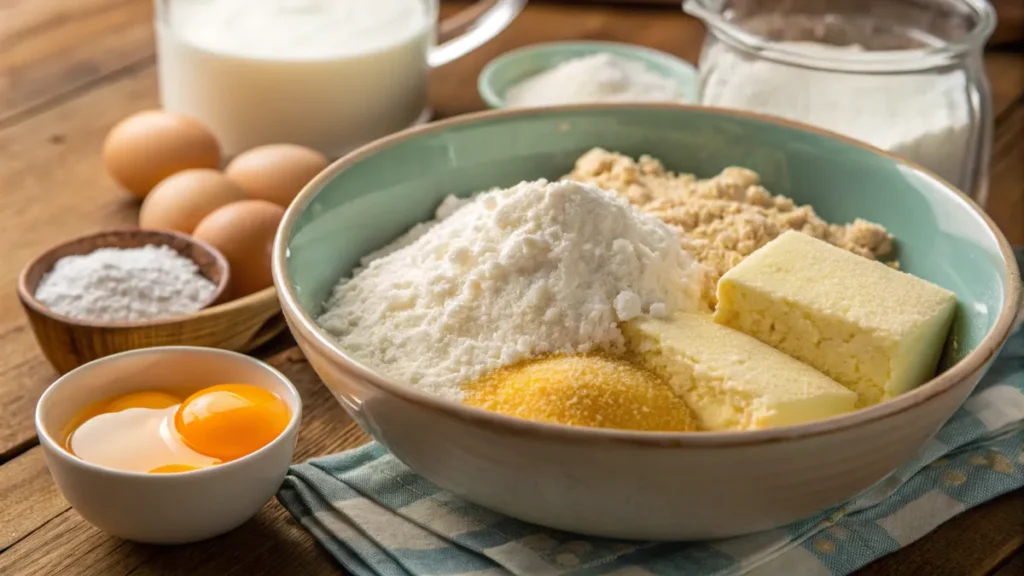
Ingredients List (Traditional and Optional Variations)
Here’s what you’ll need for a classic Southern cornbread recipe:
- 2 cups of stone-ground cornmeal
- 1 teaspoon of salt
- 1 teaspoon of baking soda
- 2 cups of buttermilk
- 1 large egg
- 2 tablespoons of bacon grease or melted butter
Optional Additions:
- Chopped jalapeños for a spicy kick
- Shredded cheddar cheese for extra richness
Step-by-Step Instructions
- Preheat your oven to 425°F. Place a cast iron skillet in the oven to heat.
- In a mixing bowl, combine the cornmeal, salt, and baking soda.
- In a separate bowl, whisk together the buttermilk, egg, and melted bacon grease or butter.
- Gradually mix the wet ingredients into the dry ingredients until just combined. Avoid overmixing.
- Carefully remove the hot skillet from the oven. Grease it with a small amount of bacon grease or butter.
- Pour the batter into the skillet and spread it evenly.
- Bake for 20–25 minutes, or until the top is golden brown and a toothpick inserted into the center comes out clean.
- Let the cornbread cool slightly before serving.
Serving Suggestions and Pairings
Southern cornbread is best served warm with a pat of butter. It pairs beautifully with collard greens, black-eyed peas, or a hearty bowl of chili. For those who enjoy a touch of sweetness, a drizzle of honey can add flavor without compromising the traditional essence.
Would you like me to proceed with the next part, refine the current sections, or provide additional details? Let me know!
Nutritional Comparison: Sweet vs. Unsweetened Cornbread
Caloric Differences Between the Two Styles
When comparing sweet and unsweetened cornbread, the first noticeable difference is in the calorie count. Sweet cornbread includes added sugar or other sweeteners, increasing its calorie content. A typical serving of sweet cornbread may contain 50–100 more calories than its unsweetened counterpart.
On the other hand, unsweetened Southern cornbread is leaner, relying on natural ingredients like cornmeal and buttermilk. This simplicity is one reason why Southerners do not put sugar in cornbread. They focus on making the dish flavorful without adding unnecessary calories.
Nutritional Benefits of Traditional Cornbread
Traditional Southern cornbread is rich in nutrients. It’s a good source of complex carbohydrates and dietary fiber, especially when made with stone-ground cornmeal. Additionally, buttermilk provides calcium and probiotics, supporting digestive health.
Unlike sweet cornbread, the absence of sugar keeps the glycemic index lower, making unsweetened cornbread a better option for those managing blood sugar levels.
A Table Comparing Ingredients and Macros
| Nutritional Element | Unsweetened Cornbread (1 slice) | Sweet Cornbread (1 slice) |
|---|---|---|
| Calories | ~150 | ~200 |
| Sugar | 0g | ~10g |
| Fat | ~5g | ~6g |
| Protein | ~3g | ~3g |
| Fiber | ~2g | ~1g |
This table highlights the lighter and more natural composition of traditional Southern cornbread. It’s another reason many cooks stay true to the original recipe.
The Enduring Legacy of Unsweetened Cornbread
Why Southerners Continue This Tradition
The question why Southerners not put sugar in cornbread can be answered by looking at the dish’s enduring legacy. Southern cornbread represents history, practicality, and a love for simple, honest flavors. By keeping it unsweetened, Southerners preserve a connection to their past.
For many families, cornbread is more than a food it’s a tradition passed down through generations. It’s a symbol of resilience, simplicity, and the resourcefulness that defines Southern culture.
Keeping the Tradition Alive in Modern Times
Even in today’s world of culinary experimentation, unsweetened cornbread remains a staple in many Southern kitchens. From holiday gatherings to everyday meals, its presence is a reminder of the region’s rich heritage.
To keep the tradition alive, Southern cooks often teach their children how to make cornbread the old-fashioned way. This ensures the flavors and values tied to the dish will continue for generations to come.
Common Myths About Southern Cornbread
Myth 1: Southerners Don’t Like Sweet Foods
Many people think Southerners avoid sweet foods entirely. However, this isn’t true. Southern cooking includes desserts like pecan pie, banana pudding, and sweet tea. This preference highlights why Southerners do not put sugar in cornbread.
Myth 2: All Cornbread Recipes Need Flour
Another common belief is that all cornbread recipes require flour. However, traditional Southern cornbread uses 100% cornmeal. This choice creates a crumbly texture and a bold, natural corn flavor. While some modern recipes add flour for a softer texture, purists stick to the authentic method to preserve its traditional character.
Myth 3: Unsweetened Cornbread Lacks Flavor
Some argue that unsweetened cornbread tastes bland, but this couldn’t be further from the truth. The richness of cornmeal, combined with tangy buttermilk and savory bacon grease, creates a deeply satisfying flavor. Adding sugar often masks these subtle, complex notes, which are the heart of what makes Southern cornbread so special.
Southern Cornbread in Modern Cuisine
How Restaurants are Showcasing Cornbread
Southern restaurants are reimagining cornbread in creative ways. Many pair it with gourmet dishes like smoked barbecue or seasonal soups. These chefs highlight the savory flavors that define traditional recipes. This approach also aligns with the idea of why Southerners do not put sugar in cornbread.
Cornbread Beyond the South
Southern cornbread is now a favorite across the country. Many food bloggers and chefs outside the South have embraced the traditional recipe. They love its simplicity and flexibility. From casseroles to skillet dishes, cornbread adds a touch of authenticity to any meal.
Conclusion: A Dish Rooted in Tradition
Cornbread is more than just a side dish it’s a reflection of Southern heritage and culinary pride. The ongoing debate over sugar highlights how deeply passionate people are about this timeless dish. For many, the answer to why Southerners do not put sugar in cornbread is simple: they aim to honor tradition and let the natural flavor of cornmeal shine.
As chefs experiment with new flavors and modern twists, the classic recipe remains at the heart of Southern cooking. Whether paired with a pot of collard greens, served alongside a bowl of chili, or enjoyed on its own, unsweetened cornbread continues to bring people together. In doing so, it preserves a rich and timeless tradition for generations to come.

